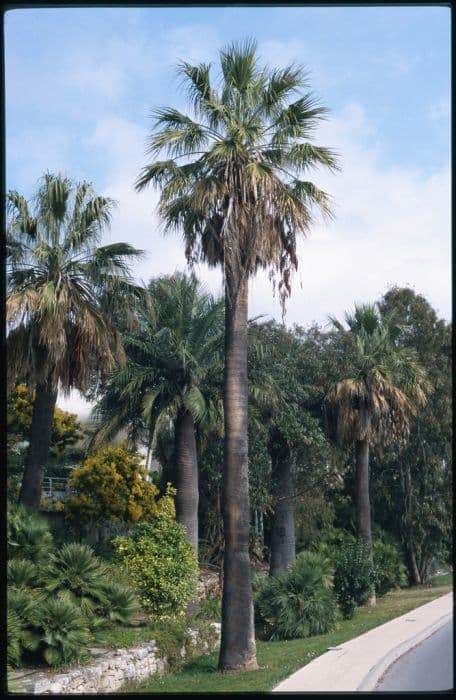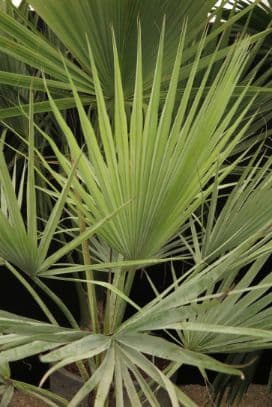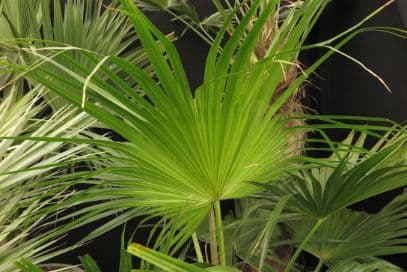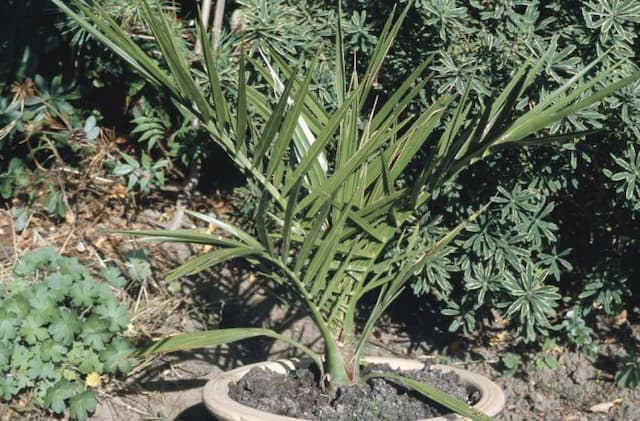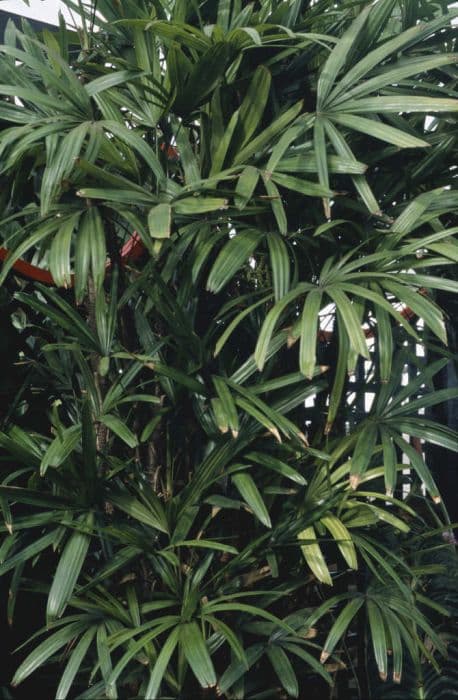European Fan Palm Chamaerops humilis

ABOUT
The plant commonly known as the European fan palm has a distinctive appearance that sets it apart in the world of palms. Its leaves are shaped like fans, which is a characteristic feature of this species. The leaves are typically a deep green color, though some may bear a silvery or bluish tinge. Each fan-like leaf is composed of multiple leaflets radiating out from a central point, much like the spokes of a wheel. The leaflets themselves are stiff and have pointed tips, contributing to the plant's overall spiky look. The edges of the leaflets might also be somewhat jagged, giving the foliage a slightly unkempt appearance. These leaves grow from multiple stems that emerge from the base of the plant, creating a dense, bushy effect. The stems of the European fan palm are covered in rough, fibrous material that gives them a rugged texture. Occasionally, older stems will display remnants of dead leaves that have not completely detached, contributing to a shaggy aesthetic. Throughout the year, and more prominently during certain seasons, the European fan palm may produce clusters of small flowers. These blossoms are usually yellow, adding a subtle splash of color to the plant. Following the flowering period, small fruits may develop, which are often yellowish or brownish in color when ripe. The plant's overall silhouette is rounded and somewhat irregular, giving it a natural and informal presence in the landscape. It has a sturdy look and is often used in gardens and landscaping to provide a touch of Mediterranean or exotic charm. All these features combined make the European fan palm a highly recognizable and attractive addition to any suitable environment.
About this plant
 Names
NamesFamily
Arecaceae.
Synonyms
European Fan Palm, Mediterranean Dwarf Palm, Dwarf Fan Palm.
Common names
Chamaerops humilis var. depressa, Chamaerops humilis var. humilis, Chamaerops arborea, Chamaerops depressa, Chamaerops humilis var. arborescens, Chamaerops humilis var. cerifera, Chamaerops humilis var. macrocarpa, Chamaerops humilis var. nana, Chamaerops humilis var. nobilis, Chamaerops humilis var. pluriflora, Chamaerops serratifolia, Sabal humilis.
 Toxicity
ToxicityTo humans
Chamaerops humilis, commonly known as the European fan palm, is not known to be toxic to humans. Ingesting parts of this plant is not likely to cause poisoning or serious consequences for human health. However, it is always advisable to avoid eating ornamental plants as they are not intended for consumption and there may be individual allergic reactions or gastrointestinal discomfort.
To pets
The European fan palm, while not considered highly toxic, can cause mild to moderate gastrointestinal discomfort if ingested by pets. Symptoms could include vomiting, diarrhea, or possibly drooling. It's recommended to keep an eye on pets to prevent them from chewing on the plant, and consult a vet if you suspect your pet has ingested a part of it and is displaying symptoms.
 Characteristics
CharacteristicsLife cycle
Perennials
Foliage type
Evergreen
Color of leaves
Green
Flower color
Yellow
Height
6-10 feet (1.8-3 m)
Spread
6-10 feet (1.8-3 m)
Plant type
Palm
Hardiness zones
8-11
Native area
Mediterranean
Benefits
 General Benefits
General Benefits- Low maintenance: Chamaerops humilis, commonly known as the European fan palm, is known for being easy to care for, requiring minimal pruning and upkeep.
- Drought tolerant: This species is highly drought-resistant, making it an excellent plant for xeriscaping and dry, water-scarce environments.
- Cold hardy: It can tolerate low temperatures, making it suitable for a range of climates and a good choice for landscaping in cooler regions.
- Wind resistant: The European fan palm has a robust nature that allows it to withstand strong winds, which is beneficial for coastal and exposed areas.
- Ornamental appeal: With its distinctive fan-shaped leaves and compact size, it adds aesthetic value to gardens, patios, and public spaces.
- Adaptability: Chamaerops humilis can grow in a variety of soil types, from sandy to clay, as long as it has good drainage.
- Erosion control: The plant's root system helps to stabilize the soil, reducing erosion on slopes and banks.
- Habitat support: It provides shelter and food for a variety of wildlife, including birds and insects, promoting biodiversity.
- Salt tolerance: This palm can tolerate salt spray, making it ideal for planting in coastal areas and near roads where de-icing salts are used.
- Urban landscaping: Due to its size and tolerance for pollution, the European fan palm is well-suited for urban environments and street-side plantings.
- Privacy screening: When planted in groups, Chamaerops humilis can create natural privacy screens and hedges.
 Medical Properties
Medical Properties- Anti-inflammatory: Chamaerops humilis, also known as the European Fan Palm, has extracts that may possess anti-inflammatory properties.
- Antimicrobial: The plant has been studied for potential antimicrobial effects against various microorganisms.
- Antioxidant: Some studies suggest that the European Fan Palm may contain antioxidant compounds that can help in neutralizing harmful free radicals in the body.
 Air-purifying Qualities
Air-purifying QualitiesThis plant is not specifically known for air purifying qualities.
 Other Uses
Other Uses- Woven Textiles: The strong and flexible fibers from the leaves of the Chamaerops humilis, commonly known as the European fan palm, are used in traditional Mediterranean crafts for weaving baskets, mats, and hats.
- Livestock Feed: Leaves of the European fan palm can be used as emergency fodder for livestock during periods of food scarcity.
- Thatching Material: The leaves are also used for thatching roofs in rural areas, providing natural insulation and weatherproofing for houses.
- Windbreaks: Planted in rows, the European fan palm can act as a windbreak to protect crops and soil from erosion.
- Garden Ornamentation: Due to its unique appearance and resilience to drought, the European fan palm is often used for ornamental purposes in gardens and parks.
- Fish Trap Construction: The flexible fronds can be utilized to create traditional fish traps in coastal Mediterranean regions.
- Dyes: Parts of the plant can be used to produce natural dyes for coloring textiles and other materials.
- Ritual Uses: In some cultures, parts of the European fan palm are used in ceremonial or religious practices.
- Handicrafts: The seeds and fibers of the palm are used to create jewelry and decorative items by local artisans.
- Soil Erosion Control: The European fan palm, with its extensive root system, is effective in stabilizing soil and preventing erosion in coastal and sandy environments.
Interesting Facts
 Feng Shui
Feng ShuiThe European Fan Palm is not used in Feng Shui practice.
 Zodiac Sign Compitability
Zodiac Sign CompitabilityThe European Fan Palm is not used in astrology practice.
 Plant Symbolism
Plant Symbolism- Resilience and Survival: Chamaerops humilis, commonly known as the European fan palm or Mediterranean dwarf palm, is native to the Mediterranean region and can thrive in tough conditions. Its hardiness symbolizes the ability to overcome adversity and persist through challenging environments.
- Longevity: This plant is known to live for many years, making it a symbol of longevity and the passage of time. Its enduring nature reflects stability and the ability to withstand the test of time.
- Protection: The European fan palm has been known to be planted near homes to provide shelter from the sun and harsh winds, symbolizing protection and care.
- Determination: As the European fan palm can grow in rocky, dry, and sandy soils, it is an emblem of determination and the capability to grow and prosper in less-than-ideal conditions.
 Water
WaterThe European Fan Palm should be watered thoroughly, allowing the top inch of soil to dry out between waterings. Typically, this would mean watering once a week, but the exact frequency depends on the climate, season, and indoor conditions. Use about half a gallon of water for an average-sized palm each time you water, ensuring it's evenly distributed around the base of the plant. During the winter months, reduce the amount of water, as the plant's growth slows down.
 Light
LightThe European Fan Palm thrives in bright, indirect light but can tolerate some direct sunlight, especially in the cooler parts of the day. Best spots for this plant would be near a window with eastern or western exposure, providing a balance of sunlight and shade throughout the day. Avoid placing it in very dark corners or full, harsh sunlight all day, as this can stress the plant.
 Temperature
TemperatureThe European Fan Palm prefers warm temperatures, ideally between 50°F and 80°F. It can tolerate occasional dips down to about 20°F but should not be exposed to such cold temperatures for extended periods. Around 70°F is considered ideal for this palm. Always keep the plant away from drafts and abrupt temperature changes.
 Pruning
PruningPrune European Fan Palms to remove dead or yellowing fronds, which helps maintain its appearance and health. This should be done carefully, cutting as close to the trunk as possible without damaging it. Pruning is best done in the spring or early summer when the plant is actively growing. Generally, an annual pruning is sufficient to keep the palm looking tidy.
 Cleaning
CleaningAs needed
 Soil
SoilThe European Fan Palm prefers well-draining soil with a mix of two parts peat, two parts pine bark, and one part coarse sand or perlite. The best soil pH for this plant is between 6.1 and 7.3.
 Repotting
RepottingEuropean Fan Palms should be repotted every other year or when roots become pot-bound, typically observed in spring or early summer.
 Humidity & Misting
Humidity & MistingEuropean Fan Palms thrive in moderate to high humidity levels, generally around 40-50% is ideal.
 Suitable locations
Suitable locationsIndoor
Place European Fan Palm in bright indirect light and ensure good air circulation.
Outdoor
Plant European Fan Palm in partial shade with shelter from strong winds.
Hardiness zone
8-11 USDA
 Life cycle
Life cycleThe life of the European fan palm, or Chamaerops humilis, starts with seed germination, which is favored by warm temperatures and can take several months. The seedlings develop a deep root system and slowly grow into juvenile palms with a rosette of fan-shaped leaves. As the plant matures, it forms a stout, woody trunk and can start producing flowers after 5 to 10 years, depending on conditions. European fan palms are dioecious, meaning individual plants are either male or female; for fruit production, both sexes must be present for pollination to occur. Female palms produce yellowish flowers that develop into clusters of yellow-orange fruit when fertilized. The life cycle continues as seeds from the fruit fall to the ground or are dispersed, and under suitable conditions, they germinate to start the cycle anew.
 Propogation
PropogationPropogation time
Spring-Early Summer
Propogation: The European Fan Palm, Chamaerops humilis, is most commonly propagated by seed. The best time to sow the seeds is in late winter or early spring when temperatures can be consistently maintained between 80-85°F (approximately 27-29°C). To propagate, seeds should be soaked in warm water for 24 to 48 hours to help break dormancy. After soaking, the seeds can be sown in a well-draining potting mix, lightly covered with soil, and kept moist until germination occurs, which may take several weeks or even months. A warm and humid environment greatly enhances the germination rate, and it’s important to keep the soil consistently moist but not waterlogged. Once the seeds have sprouted and the seedlings are big enough to handle, they can be transplanted into individual pots to continue growing until they are ready to be moved outdoors or into larger containers.



